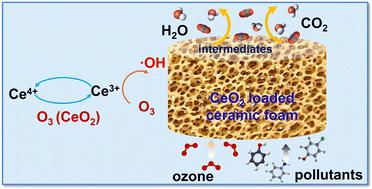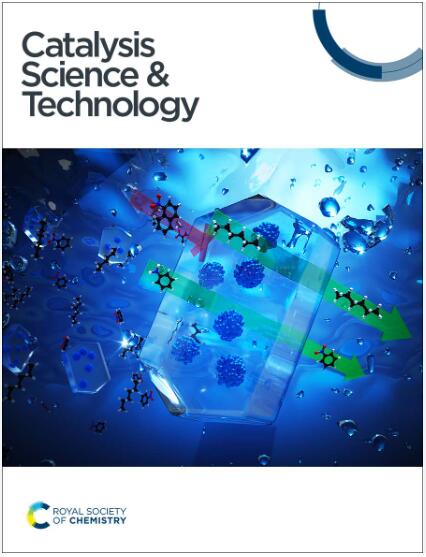CeO2-modified monolithic ceramic foams for efficient catalytic ozonation of refractory organic pollutants in a continuous-flow reactor†
IF 4.4
3区 化学
Q2 CHEMISTRY, PHYSICAL
引用次数: 0
Abstract
Heterogeneous catalytic ozonation is valid for the advanced oxidation of organic pollutants in wastewater, but it is usually used in the packing bed with granular supports/catalysts with considerable fluid resistance and unsatisfactory ozone utilization efficiency in practical wastewater treatment. Herein, CeO2-modified monolithic ceramic foams (CeO2/AlCF) were developed for the efficient catalytic ozonation of refractory organic pollutants in a continuous-flow mode. The TOC removal efficiency of phenol by CeO2/AlCF was about 80% with a hydraulic retention time (HRT) of 12 min. The system also showed high TOC removal efficiencies (68%–81%) for other organic pollutants including oxalic acid, 2,4-dimethylphenol, and p-nitrophenol. The chemical oxygen demand (COD) of the biological treatment effluent of petrochemical wastewater decreased from 136 mg L−1 to 45.2 mg L−1 with a COD removal efficiency of nearly 67%. The ozone utilization efficiencies of CeO2/AlCF ranged from 53% to 73%, which were much higher than those of granular catalysts (42–68%). The quenching experiments and EPR analysis revealed that the process followed a hydroxyl radical mechanism. H2 temperature-programmed reduction (H2-TPR) analysis showed that the transition of Ce4+ to Ce3+ in CeO2/AlCF was much easier than that in CeO2 and hence had a better catalytic capability.

用于在连续流反应器中高效催化臭氧分解难降解有机污染物的 CeO2 改性整体陶瓷泡沫†。
异相催化臭氧氧化法适用于废水中有机污染物的高级氧化,但在实际废水处理中,它通常是在填料床中使用颗粒支撑物/催化剂,流体阻力较大,臭氧利用效率不理想。本文开发了 CeO2 改性整体陶瓷泡沫(CeO2/AlCF),用于在连续流模式下高效催化臭氧去除难降解有机污染物。CeO2/AlCF 对苯酚 TOC 的去除率约为 80%,水力停留时间(HRT)为 12 分钟。该系统对草酸、2,4-二甲基苯酚和对硝基苯酚等其他有机污染物的 TOC 去除率也很高(68%-81%)。石化废水生物处理出水的化学需氧量(COD)从 136 mg L-1 降至 45.2 mg L-1,COD 去除率接近 67%。CeO2/AlCF 的臭氧利用率为 53% 至 73%,远高于颗粒催化剂(42%-68%)。淬灭实验和 EPR 分析表明,该过程遵循羟基自由基机制。H2 温度编程还原(H2-TPR)分析表明,CeO2/AlCF 中 Ce4+ 向 Ce3+ 的转变比 CeO2 中容易得多,因此具有更好的催化能力。
本文章由计算机程序翻译,如有差异,请以英文原文为准。
求助全文
约1分钟内获得全文
求助全文
来源期刊

Catalysis Science & Technology
CHEMISTRY, PHYSICAL-
CiteScore
8.70
自引率
6.00%
发文量
587
审稿时长
1.5 months
期刊介绍:
A multidisciplinary journal focusing on cutting edge research across all fundamental science and technological aspects of catalysis.
Editor-in-chief: Bert Weckhuysen
Impact factor: 5.0
Time to first decision (peer reviewed only): 31 days
文献相关原料
公司名称
产品信息
阿拉丁
cerium nitrate
 求助内容:
求助内容: 应助结果提醒方式:
应助结果提醒方式:


